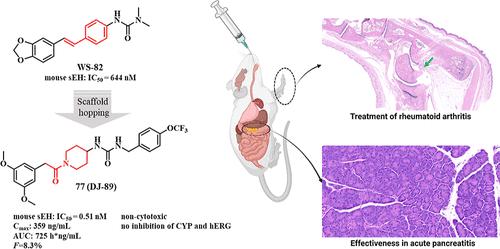Discovery of Phenylacylpiperidine as Novel sEH Inhibitors through Scaffold Hopping of Natural Stilbene
IF 6.8
1区 医学
Q1 CHEMISTRY, MEDICINAL
引用次数: 0
Abstract
Despite the development of soluble epoxide hydrolase (sEH) inhibitors as a promising therapeutic approach, no drug candidate has successfully progressed beyond clinical phase II, highlighting the need for a novel chemotype with improved in vivo potency, pharmacokinetics and safety. In this study, we discovered a phenylacetylpiperidine-based compound, 77 (lab code: DJ-89; IC50: 0.51 nM), through strategic scaffold hopping from previously reported styrene-based sEH inhibitors. Resolving the cocrystal structure and mode-of-action studies revealed a distinct profile compared to well-known sEH inhibitors TPPU and EC5026 (IC50: 44, 19 nM). Notably, 77 demonstrated additional interactions with sEH compared to TPPU, and uniquely enhanced anti-inflammatory factors, including EET levels and IL-10, a capability not observed with EC5026. Moreover, 77 showed excellent pharmacokinetics and safety, positioning it as a promising candidate for treating both acute and chronic inflammatory diseases, including rheumatoid arthritis, leveraging phenylacylpiperidine scaffolds in sEH-targeted therapies.

通过天然二苯乙烯的支架跳变发现苯基酰基哌啶作为新型sEH抑制剂
尽管可溶性环氧化物水解酶(sEH)抑制剂作为一种很有前景的治疗方法,但没有一种候选药物成功地发展超过临床II期,这突出了对一种具有改善体内效力、药代动力学和安全性的新型化学型的需求。在这项研究中,我们发现了一个基于苯乙酰哌啶的化合物,77(实验室代码:DJ-89;IC50: 0.51 nM),通过先前报道的苯乙烯基sEH抑制剂的战略性支架跳跃。与已知的sEH抑制剂TPPU和EC5026 (IC50: 44, 19 nM)相比,解析共晶结构和作用模式研究揭示了不同的特征。值得注意的是,与TPPU相比,77例与sEH表现出额外的相互作用,并独特地增强了抗炎因子,包括EET水平和IL-10,这是EC5026所没有的。此外,77显示出良好的药代动力学和安全性,使其成为治疗急性和慢性炎症性疾病(包括类风湿关节炎)的有希望的候选药物,利用苯酰基哌啶支架进行seh靶向治疗。
本文章由计算机程序翻译,如有差异,请以英文原文为准。
求助全文
约1分钟内获得全文
求助全文
来源期刊

Journal of Medicinal Chemistry
医学-医药化学
CiteScore
4.00
自引率
11.00%
发文量
804
审稿时长
1.9 months
期刊介绍:
The Journal of Medicinal Chemistry is a prestigious biweekly peer-reviewed publication that focuses on the multifaceted field of medicinal chemistry. Since its inception in 1959 as the Journal of Medicinal and Pharmaceutical Chemistry, it has evolved to become a cornerstone in the dissemination of research findings related to the design, synthesis, and development of therapeutic agents.
The Journal of Medicinal Chemistry is recognized for its significant impact in the scientific community, as evidenced by its 2022 impact factor of 7.3. This metric reflects the journal's influence and the importance of its content in shaping the future of drug discovery and development. The journal serves as a vital resource for chemists, pharmacologists, and other researchers interested in the molecular mechanisms of drug action and the optimization of therapeutic compounds.
 求助内容:
求助内容: 应助结果提醒方式:
应助结果提醒方式:


